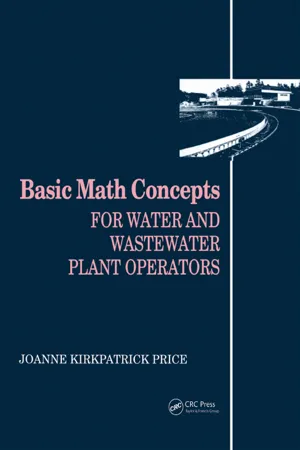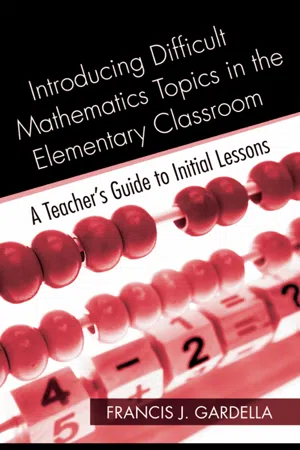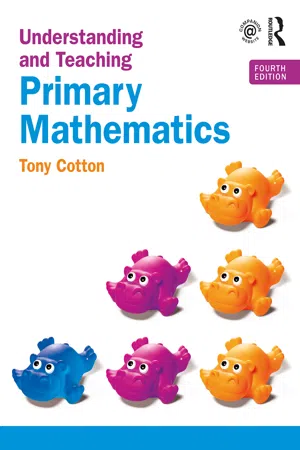Mathematics
Rounding
Rounding is the process of approximating a number to a certain place value, such as a whole number or a specific decimal place. When rounding, numbers are adjusted to make them easier to work with or understand. This is commonly used in everyday calculations and in situations where precise values are not necessary.
Written by Perlego with AI-assistance
Related key terms
Related key terms
1 of 4
Related key terms
1 of 3
3 Key excerpts on "Rounding"
- eBook - ePub
Basic Math Concepts
For Water and Wastewater Plant Operators
- Joanne K. Price(Author)
- 2018(Publication Date)
- Routledge(Publisher)
14 Rounding and EstimatingSKILLS CHECK14.1 Rounding SUMMARYComplete and score the following skills test. Each section should be scored separately in the box provided to the right. A score of 4 or above indicates that you are sufficiently strong in that concept. A score of 3 or below indicates a review of that section is advisable.Rounding may be necessary when estimating an answer or when giving an answer to a specified number of significant figures.1. In order to round a number you must know the place value system.To the left of the decimal point are the following place values:To the right of the decimal point are the following place values:2. Rounding procedures depend on whether the number to the right of the “Rounding place” is less than 5, equal to 5, or greater than 5. The procedures also vary depending on whether the entire number being rounded is less than one or greater than one.In order to round, it is essential to know the name and value of each place in the place value system. A diagram of the most common place values is given in the box to the right. Note that place values less than one include a “th” on the end of the word. This helps distinguish these place values from those greater than one.WHEN Rounding NUMBERS TO THE LEFT OF THE DECIMAL POINTThe Rounding procedures are slightly different for numbers rounded to the left of the decimal point than for numbers rounded to the right of the decimal point. When Rounding to the left of the decimal point:1. Find the “Rounding place” as stated by the problem. The number in that position will either stay the same or will be increased by one, depending on the size of the number to the right of the “Rounding place.”2. If the number to the right is 5 or greater - eBook - ePub
Introducing Difficult Mathematics Topics in the Elementary Classroom
A Teacher's Guide to Initial Lessons
- Francis J. Gardella(Author)
- 2008(Publication Date)
- Routledge(Publisher)
Rounding as one skill in developing estimation is a major part of developing number sense in students. It is also very important in the development of quantitative literacy. The reason for this is that estimation of sums, differences, and products can be done in several ways. It calls for the person to be “flexible” with numbers and operations and use the conceptual basis for working with numbers in prescribed as well as individual and yet correct ways. Rounding is one way of estimating and, to date, the most popular in mathematics curriculum. This may be because it is so procedural and rule based.However, you now know that the idea that Rounding as a rule or agreement (as taught in many programs) is not accurate. The accurate idea has to do with the mathematics of real numbers which is a very deep and complex topic. But, when you begin a topic as complex as this with a major subset, the whole numbers, it allows you and your students to see that it makes sense.It is very important at any stage of mathematics to insure that your students see mathematics not as arbitrary and rule/agreement driven but as a way of communicating based on good reasons.Reflections
Reflecting on the Activity
- What were the student-centered attributes of the Activity?
- How did the teacher help move the lesson along?
- Who was more active in the lesson, the students or the teacher?
- Why did Ms. Ortiz not use words such as estimating or approximating in this first lesson?
Reflecting on the Mathematics
- 5. What would be the “lower” and “upper” numbers between 80 and 89?
- 6. Why would it be better for students to have an understanding of Rounding and not just the rule?
- 7. How would the idea behind the lesson help with helping students learn how to round to the nearest thousand?
- 8. Put yourself in the place of Ms. Ortiz. How would you change the lesson or any of its parts to fit your personality better?
Reflecting on the Plan
- 9. How do you think the warm-up would help in readying the students for the lesson?
- 10. What did Ms. Ortiz do before the lesson to be ready for the lesson?
- 11. Could she have written the problems on the chalkboard? What would this have done to the rhythm of the lesson?
Your Reflection
- 12. Write a reflection of no more than two pages (double-spaced, 12 point type) portraying your thoughts about teaching the concept of Rounding. Discuss how it fits into the learning model discussed in chapter 1
- eBook - ePub
- Tony Cotton(Author)
- 2020(Publication Date)
- Routledge(Publisher)
Pupils can now develop their understanding of partitioning so that they can partition four-digit numbers into multiples of 1000, 100, 10 and 1 in different ways. They can count from 0 in multiples of 4, 8, 50 and 100, moving on to counting in multiples of 6, 7, 9, 25 and 100. They can find 1000 more or less than a given number through ordering and comparing numbers up to 10,000. They can use this knowledge to round numbers to the nearest 10 or 100. They are also introduced to negative numbers in context at this stage.They are also ready to be introduced to fractions. They should use diagrams to identifyequivalent fractions. Examples of equivalent fractions are6 8and3 4, or70 100and7 10. Equivalent fractions have the same value. Children can also learn how to interpretmixed numbersand position them on a number line. An example of a mixed number is 33 4. It is a fraction which contains a whole number as well as a fraction. They will learn the decimal equivalents to1 4,1 2and3 4.They can also begin to explain what each digit represents in whole numbers and decimals with up to two places, and partition, round and order these numbers. The rule to remember withRoundingnumbers to a particular decimal place is that if the next number to the right of that decimal place is 5 or more, you round the figure up to the next highest number, and if it is 4 or less, it remains the same. For instance, if I were to round 4.72 to one decimal place, I would write 4.7. If I were to round to the nearest whole number, I would write 5. They will understanddecimal notationin contexts such as length and money.Extending learning in counting and place value and developing an understanding of fractions, decimals and percentages
Towards the end of their time in primary school, learners will have developed their understanding of number and place value to work up to 10,000,000 (10 million). They can round any number and use negative numbers in a context confidently. They can count on and back in fractions and decimals through 0 in both directions and understand the effect of multiplying and dividing by all multiples of 10.They understand the language offactorsandmultiplesand know whatprime numbers
Index pages curate the most relevant extracts from our library of academic textbooks. They’ve been created using an in-house natural language model (NLM), each adding context and meaning to key research topics.
Explore more topic indexes
Explore more topic indexes
1 of 6
Explore more topic indexes
1 of 4


